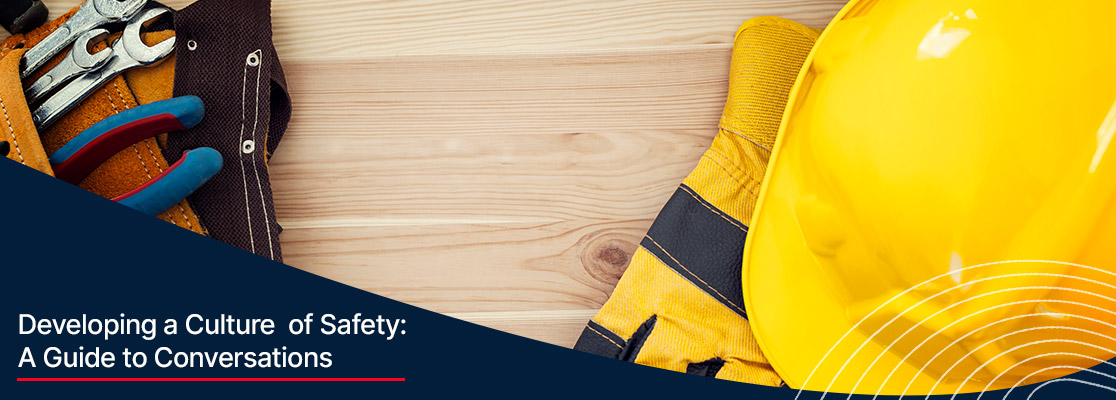Developing a Culture of Safety: A Guide to Conversations
Developing a Safety Culture can seem overwhelming. Just like any idea or project, it starts with a meaningful conversation. Having a meaningful conversation with your employees can be the most challenging part of developing a safety culture.
Meaningful conversations start with good observations. Next, it is essential to accentuate both safe and unsafe behaviors. Explore why your employee use unsafe behavior and what they need to perform the safe ones more consistently. Emphasize the importance of safe behaviors.
Finally, agree on how to implement safe behaviors moving forward.
Making Formal Observations
The biggest challenge in performing good formal observations is opening our eyes to things we have become blind to. Good observations require that we not only observe our employee’s behavior but challenge us to also look at ourselves.
We may have been letting an unsafe behavior slide simply because we do it ourselves. Safety observation forms can help with this. Safety observation forms guide us to what we should be looking for and help ensure that we are consistent in our observations.
We should not wait for a formal observation before talking to our employees performing an at-risk behavior. One of the most effective times to have a meaningful safety discussion is in the moment. This shows our employees that you expect them to be safe, not just during a formal observation.
Depending on how unsafe the behavior is, our emotions can become elevated. We must express concern will while still maintaining composure. Yelling at our employees and calling them names will undermine our attempt to change the behavior. If possible, remove yourself and the employee out of the operational environment to have the discussion.
Accentuating the Positive
After observing your employee, safety conversations should start by accentuating what your employee did well. This can be done by reinforcing the safe behaviors you observe.
For example, these forms allow for consistency and hold our employees and ourselves accountable. They can also help structure what we will discuss with our employees. Try to find three things they did well for every one thing they need to improve on. Keep the positive feedback and constructive feedback utterly separate in the conversation.
Do not join them together by using the word “but.” As soon as your employee hears the word “but,” it will negate the positive feedback you just gave them. They will only remember the constructive feedback. This will hurt employee morale in the long run.
Taking time to accentuate what an employee did makes it more likely to do the safe habit again.
When accentuating the at-risk behavior, be sure that your feedback is constructive. Provide suggestions on how they can do the task safely next time. For example, “I noticed that you were not using your PPE when cleaning the floor. Next time can you please make sure to put on your gloves and safety glasses before starting the task?”
Be sure that all feedback is directed at the behavior and not the person. For example, “you’re being unsafe” is a personal attack while “that behavior is unsafe” is not.
Safety discussions should always be held one-on-one in a private setting. This will allow the employee to feel comfortable discussing the issue without fear of reprisal.
Exploring why an employee used an at-risk behavior is essential to completing a root-cause analysis of why safe behaviors are not used. A root cause analysis will allow you to determine if there are any hindrances to performing the task safely.
You may determine that removing a barrier to performing a task safely is as simple as providing a toolbox with all the correct tools to every employee. This cannot be determined if you do not get feedback from your employee about why they performed the unsafe behavior.
Emphasizing the importance of safe behaviors is also essential. We need to remind our employees that we care about their safety and want them to go home safely every night. Encourage your employee to share about activities they like to do and how an injury would inhibit their ability to do that activity.
Empowering Employees
A safety discussion aims to get employees to take ownership of their safety. We want them to be the ones driving the change in behavior, not us. To do this, we need to avoid coming across as the Safety Police. After all, no one likes being told what they are doing wrong all the time.
Remind them that their safety behaviors also help keep their fellow teammates safe. The more you can emphasize that the safe work behaviors are for the employee’s benefit, the more likely they are to follow through on making safe choices.
Finally, agree on how to implement safe behaviors moving forward. This will help ensure that the discussion does not end with the conversation. Make sure there is a plan in place to address the at-risk behavior.
Discussing how to eliminate an at-risk behavior with your employee is critical to developing employee buy-in. This could be as simple as setting a date for when the employee will start using their PPE or implementing a new policy.
Every employee wants to feel like their concerns and suggestions are being heard and addressed. Brainstorming about how they can do the task safely in the future helps your employee feel like they are part of the process. This helps build trust and compliance. The most important part is to have the employee commit to using the new safe strategy.
Hold Safety Meetings
It can be difficult to keep the momentum going after having these conversations. One way to do this is by holding Safety Meetings.
Safety Meetings give employees a chance to share concerns and best practices. They also give managers an opportunity to re-enforce the importance of Safety in the workplace.
Safety Meetings can be held weekly, bi-weekly, or monthly depending on the size of your company. Safety meetings are a great way to engage employees in safety conversations. They provide an opportunity for everyone to share their concerns and suggestions about safety. Safety meetings also help ensure that everyone is on the same page when it comes to safety procedures.
Make sure that your safety meetings are interactive and engaging. No one wants to sit through a boring meeting. Safety games, quizzes, and videos are all great ways to get employees involved. The most important part is to make sure that the meeting is focused on the safety of your employees.
Employees should feel like they are part of the solution. One way to do this is by going over near misses or incidents that have occurred and brainstorming about how they could have been prevented.
By having these types of conversations with our employees, we can develop a culture of safety within our organization. Safety should not be seen as the responsibility of just the Safety Department but rather the responsibility of everyone. We all play a role in keeping each other safe at work.
Developing a Safety Culture takes time and effort. It is important to have meaningful conversations with your employees about Safety. These conversations should be based on good observations.
Be sure to catch both safe and unsafe behaviors. Finally, agree on a plan to change the unsafe behaviors. Safety is everyone’s responsibility.
[ux_image id=”3611″]Safety should be everyone’s top priority while at work no matter what position they hold. Developing a Safety Culture will open the door for more honest and meaningful conversations about Safety. These conversations could potentially save someone from getting hurt or even worse.
Safety is a journey, not a destination. It takes time and effort to develop a Safety Culture, but it is worth it.
Let’s all make Safety our top priority. Together we can make a difference.



